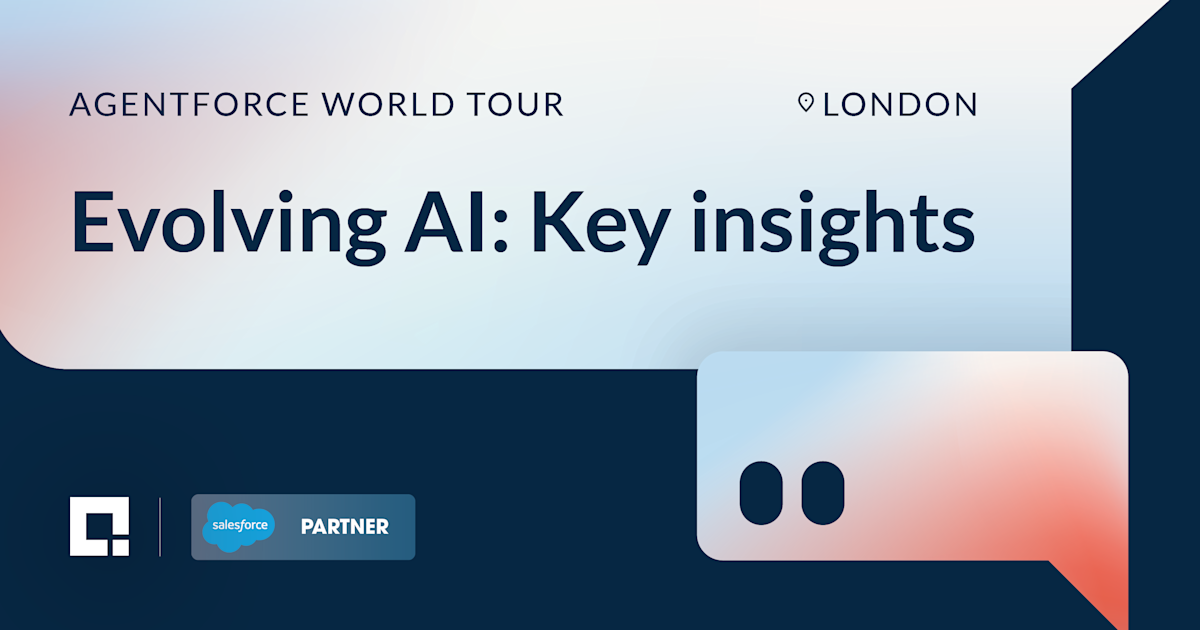
It’s remarkable to reflect on how much has changed since Cloudforce 2010 in London, when Marc Benioff himself introduced a few thousand attendees to a new product called Chatter. Fast forward to Agentforce World Tour London 2025: 15,000+ attendees, keynotes from leading UK executives, and – new this year – a combined event with TrailblazerDX.
Two events, two distinct audiences
It’s fair to say this joint format raised some questions within the Salesforce community. Traditionally, World Tour events tend to be more sales-focused, attracting prospects and decision makers from existing customers. TrailblazerDX, on the other hand, targets administrators and developers, focusing on deeper dives into the technology.
In practice, that’s pretty much how it turned out. Agentforce World Tour featured a strong sales-oriented atmosphere, with lots of Salesforce partners sponsoring stands – and in Credera’s case, a private meeting space on one of the balconies. In contrast, TrailblazerDX attracted those responsible for administering and extending Salesforce, offering them an opportunity to deepen their expertise.
The rise of the new digital workforce
Salesforce’s messaging at the event was very clear: Agentforce represents the new digital workforce. Today’s customers expect immediate yet personalised, expert yet contextual interactions – but human teams have finite capacity and risk burnout if asked to continually scale up. As Zahra Bahrololoumi, Salesforce CEO of UK & Ireland, put it during her keynote: “This is a moment where we get to extend our teams and unlock additional capacity with AI agents working alongside us.”
Salesforce emphasised that while agents provide a potentially limitless workforce, they are not about replacing humans. Expertise is only valuable if it is accurate and trustworthy, and AI agents look to humans when validation is needed or when issues can’t be solved autonomously. This dovetails with Credera’s perspective that the future of AI is human. While AI agents may serve as the front line for initial customer interactions, they must be able to collaborate seamlessly with human experts to provide the best possible customer experience.
New ways of recruitment, with human oversight
The keynote demonstration of Agentforce at work in Capita’s recruitment function was a refreshing change from the usual restaurant booking and product return scenarios beloved by many AI vendors. Having been involved in the recruitment process for over 30 years, I’ve seen first-hand the significant effort that is put into routine, often manual workflows for screening applications, scheduling (and rescheduling!) interviews involving multiple internal and external stakeholders, and managing communications. Allowing agents to take care of these tasks frees up recruiters to focus on more meaningful work, such as assessing cultural and team fit, handling sensitive conversations (including rejections), and negotiating complex offers.
One important area that, in my opinion, could have been explored further in the demo is the critical human role in reviewing outcomes to ensure the use of AI does not introduce systemic bias.
Governance, security, testing
I was pleased to see governance and security addressed during the event. As the pace of agent adoption accelerates, setting robust safeguards is essential before deploying them into production. And it’s good to see the associated Salesforce tools ramping up.
Agents bring a very different testing paradigm to traditional automation. But the Agentforce Testing Center, for example, provides a way to validate an agent’s decision-making, reliability, and alignment with business needs. Some very interesting tools, coming out later in the year, will further improve observability and traceability. This will prove vital for understanding agent actions and ensuring safety, compliance, and trust, especially where it isn’t possible to deterministically test all paths and outcomes.
Adoption: Bringing people along
Another area of Agentforce implementation where humans are crucial is adoption. Adolfo Hernandez, Capita CEO, covered this at length during his keynote interview, highlighting the importance of including users in the journey. Capita is investing in Data Academies, AI Academies, and AI Apprenticeships to prepare its workforce for an AI-enabled future. In my view, this is the right approach – engaging users from the outset helps ensure AI initiatives are embraced, rather than seen as imposed.
A matter of price
No Agentforce event would be complete without mention of pricing. While this was briefly covered during the Day 1 keynote, I recommend the TrailblazerDX session on Day 2, ‘Consumption Metrics Explained: Data Cloud and Agentforce’. This session offered a thorough walkthrough of the costs associated with Agentforce and Data Cloud, including practical examples for estimating charges based on data volumes, processing, and actions.
Community highlights
To close, I’d like to mention two personal highlights:
Credera’s Mezzanine drinks reception providing a platform for the Shirtforce team to share their impactful work.
Salesforce recognising Will Turner’s outstanding contribution to the community with a Golden Hoodie award – a well-deserved honour for a popular and dedicated member!
If you’re looking to understand where your organisation stands on its AI journey, we recommend starting with Credera’s online AI Maturity Health Assessment. This quick and easy tool allows business and technology leaders to evaluate AI maturity across the key capabilities required to succeed and scale in the AI era.
For those interested in exploring industry-specific frameworks, Salesforce has also published a helpful Agentic Maturity Model outlining four key stages of progression and actionable steps for scaling agents effectively across the business.
Contact Us
Ready to achieve your vision? We're here to help.
We'd love to start a conversation. Fill out the form and we'll connect you with the right person.
Searching for a new career?
View job openings

